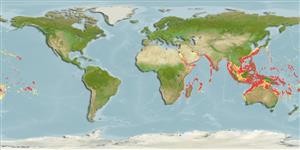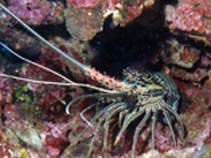Panulirus versicolor (Latreille, 1804)
Painted spiny lobster| Native range | All suitable habitat | Point map | Year 2050 |

|
| This map was computer-generated and has not yet been reviewed. |
| Panulirus versicolor AquaMaps Data sources: GBIF OBIS |
Classification / Names Common names | Synonyms | CoL | ITIS | WoRMS
| Decapoda | Palinuridae
Environment: milieu / climate zone / depth range / distribution range Ecologie
; diepteverspreiding 0 - 900 m (Ref. 4). Tropical; 35°N - 32°S, 31°E - 134°W (Ref. 4)
Verspreiding Landen | FAO regio's | Ecosystems | Voorkomen | Introducties
Indo-Pacific: from South Africa to Hawaii, including Red Sea and Persian Gulf, from Japan to Australia.
Length at first maturity / Size / Gewicht / Leeftijd
Maturity: Lm 7.8, range 8 - ? cm Max length : 40.0 cm TL mannelijk/geslacht niet bekend; (Ref. 4)
Minimum depth from Ref. 96667. It has a maximum total body length of 40 cm, and an average length less than 30 cm (Ref. 4). Maximum depth from Ref. 105426. It occurs in shallow water, from the sublittoral down to 15 m; in coral reef areas, often on seaward edges of the reef plateau; in clear water also in surf areas. The species is nocturnal and not gregarious; in daytime, it hides in crevices and cavities of the rocks (Refs. 4, 9773). In general, palinurids are mainly considered carnivores, usually feeding upon sluggish, easily captured animals where most material is eaten alive or freshly killed (Ref. 105260). Feeds on bivalve mollusks and sea urchins (Ref. 9773).
Life cycle and mating behavior Geslachtsrijpheid | Voortplanting | Kuitschieten | Eieren | Fecundity | Larven
Members of the order Decapoda are mostly gonochoric. Mating behavior: Precopulatory courtship ritual is common (through olfactory and tactile cues); usually indirect sperm transfer.
Voornaamste referentie
Referenties | Coördinator | Medewerkers
Holthuis, L.B. 1991. (Ref. 4)
Status op de Rode Lijst van het IUCN (Ref. 130435)
Niet bedreigd (LC) ; Date assessed: 03 December 2009
Status bij CITES (Ref. 108899)
Not Evaluated
CMS (Ref. 116361)
Not Evaluated
Gevaarlijk voor mensen
Gebruik door de mens
Visserij: commercieel
| FishSource | Sea Around Us
Tools
Meer informatie
Populaire namen
Synoniemen
Predators
Voortplanting
Geslachtsrijpheid
Kuitschieten
Fecundity
Eieren
Ontwikkeling van de eieren
Synoniemen
Predators
Voortplanting
Geslachtsrijpheid
Kuitschieten
Fecundity
Eieren
Ontwikkeling van de eieren
Internet-bronnen
BHL | BOLD Systems | CISTI | DiscoverLife | FAO(Publication : search) | Fishipedia | GenBank (genoom, nucleotide) | GloBI | Gomexsi | Google Books | Google Scholar | Google | PubMed | Tree of Life | Wikipedia (ga naar, zoek) | Zoological Record
Estimates based on models
Preferred temperature
(Ref. 115969): 9.8 - 22.9, mean 15.4 (based on 644 cells).
Weerstandsvermogen
(Ref. 69278):
Gemiddeld, minimale populatieverdubbelingstijd 1,4-4,4 jaar (K=0.27; tm=3).
Prior r = 1.19, 95% CL = 0.79 - 1.79, Based on 1 data-limited stock assessment.
Nutrients: Calcium = 109 [35, 184] mg/100g; Iron = 1.59 [1.21, 1.97] mg/100g; Protein = 20.2 [19.2, 21.3] %; Omega3 = 0.285 [0.185, 0.386] g/100g; Selenium = 48.3 [-31.7, 128.3] μg/100g; VitaminA = 0 μg/100g; Zinc = 1.79 [1.17, 2.40] mg/100g (wet weight).



